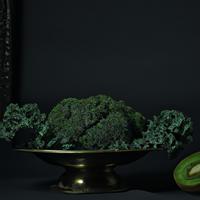
1 serving (91 grams) contains 31 calories, 2.5 grams of protein, 0.3 grams of fat, and 6.0 grams of carbohydrates.

Log this food in SnapCalorie

Nutrition Information
Calories |
31 | ||
|---|---|---|---|
% Daily Value* |
|||
| Total Fat | 0.3 g | 0% | |
| Saturated Fat | 0.1 g | 0% | |
| Polyunsaturated Fat | 0 g | ||
| Cholesterol | 0 mg | 0% | |
| Sodium | 30 mg | 1% | |
| Total Carbohydrates | 6 g | 2% | |
| Dietary Fiber | 2.4 g | 8% | |
| Sugars | 1.5 g | ||
| protein | 2.5 g | 5% | |
| Vitamin D | 0 mcg | 0% | |
| Calcium | 43 mg | 3% | |
| Iron | 0.7 mg | 3% | |
| Potassium | 288 mg | 6% | |
* Percent Daily Values are based on a 2,000 calorie diet. Your daily values may be higher or lower depending on your calorie needs.
Food Attributes
Source of Calories
About Broccoli and kale
Broccoli and kale are nutrient-packed green vegetables celebrated for their health benefits and versatility. Broccoli, originating from the Mediterranean, is a cruciferous vegetable high in fiber, vitamin C, potassium, and antioxidants like sulforaphane, which support heart health and may reduce inflammation. Kale, a leafy green with roots in Europe, is a superfood rich in vitamins A, K, and C, along with calcium, iron, and powerful phytonutrients. Both vegetables are low in calories and ideal for maintaining a balanced diet. While broccoli is popular in stir-fries, soups, and roasting, kale is commonly enjoyed raw in salads, blended in smoothies, or cooked in hearty dishes. Their slightly bitter and earthy flavors complement various cuisines. Excessive consumption may cause digestive discomfort due to their fiber content, but in moderation, broccoli and kale are excellent additions to a nutritious lifestyle.



